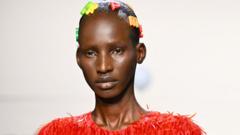In recent years, the fashion industry has seen an impressive rise of models from South Sudan, characterized by their unique beauty and diverse stories. Arop Akol, a promising model now in her early twenties, has garnered attention for walking runways across Europe, including sharing the stage with renowned supermodel Naomi Campbell. "I've always dreamed of modelling since I was 11," says Akol, who recalls the moment she was scouted in 2019 during a tumultuous time in South Sudan, marked by conflict and migration.
South Sudan's rich diaspora has contributed to the emergence of models such as Anok Yai, Adut Akech, and Alek Wek, the latter being one of the first to achieve global recognition after being discovered in a London car park in 1995. Today, one in five models in the prestigious Models.com "future stars" list has South Sudanese roots, underlining the industry's current preference for models with dark skin and striking features.
Fashion insiders attribute this growing preference partly to the inherent beauty within this demographic. "They possess the perfect, dark skin, height, and resilience," says Dawson Deng, co-organizer of South Sudan Fashion Week in Juba. Female models like Akur Goi support this theory, asserting that their journeys reflect inner resilience shaped by their war-torn backgrounds. Many fled the civil unrest that erupted shortly after South Sudan gained independence in 2011, leading to significant displacement and hardship.
While the fashion world celebrates their beauty, it comes with challenges. Aspiring models often face exploitation through high upfront fees demanded by agencies, leading to distress and uncertainty. Akol recalls her early experiences navigating the tough landscape of the fashion industry, where initial opportunities often came with undesirable expectations.
Despite the setbacks, models from South Sudan are starting to carve out a space in the modelling world. They often acknowledge family hesitance regarding such careers, faced with perceptions that equate modelling with inappropriate behavior. Yet, with increasing acceptance among urban populations, many have begun to see modelling as a respected profession—serving as providers for their families.
South Sudanese models are here to stay. Their unique blend of background, resilience, and beauty not only enriches the global modelling scene but also embodies hope for a brighter future for many in their homeland. "The demand for diversity is rising," asserts Akol, highlighting the robust journey ahead for South Sudanese representation in fashion. As trends change, the impactful legacy of models from South Sudan continues to inspire and uplift.
South Sudan's rich diaspora has contributed to the emergence of models such as Anok Yai, Adut Akech, and Alek Wek, the latter being one of the first to achieve global recognition after being discovered in a London car park in 1995. Today, one in five models in the prestigious Models.com "future stars" list has South Sudanese roots, underlining the industry's current preference for models with dark skin and striking features.
Fashion insiders attribute this growing preference partly to the inherent beauty within this demographic. "They possess the perfect, dark skin, height, and resilience," says Dawson Deng, co-organizer of South Sudan Fashion Week in Juba. Female models like Akur Goi support this theory, asserting that their journeys reflect inner resilience shaped by their war-torn backgrounds. Many fled the civil unrest that erupted shortly after South Sudan gained independence in 2011, leading to significant displacement and hardship.
While the fashion world celebrates their beauty, it comes with challenges. Aspiring models often face exploitation through high upfront fees demanded by agencies, leading to distress and uncertainty. Akol recalls her early experiences navigating the tough landscape of the fashion industry, where initial opportunities often came with undesirable expectations.
Despite the setbacks, models from South Sudan are starting to carve out a space in the modelling world. They often acknowledge family hesitance regarding such careers, faced with perceptions that equate modelling with inappropriate behavior. Yet, with increasing acceptance among urban populations, many have begun to see modelling as a respected profession—serving as providers for their families.
South Sudanese models are here to stay. Their unique blend of background, resilience, and beauty not only enriches the global modelling scene but also embodies hope for a brighter future for many in their homeland. "The demand for diversity is rising," asserts Akol, highlighting the robust journey ahead for South Sudanese representation in fashion. As trends change, the impactful legacy of models from South Sudan continues to inspire and uplift.


















